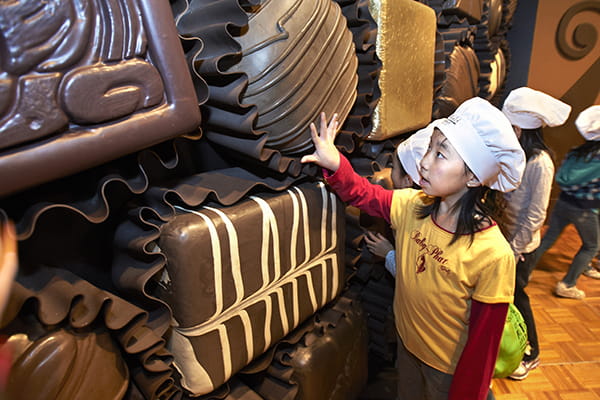Chocolate, exotic birds and natural history humor: Special Exhibits Coming to Academy in 2014

The mating rituals of elusive birds, a humorous look into natural history museums and the history of chocolate — yes, chocolate — will be featured in a series of exciting new exhibitions in 2014 at the Academy of Natural Sciences of Drexel University. In addition, for three days in early spring the entire museum will be transformed into a splendid showcase for one of the nation’s largest international orchid shows.
Below is the museum’s schedule of exhibits for 2014. For frequent updates, visit ansp.org.
Through March 30
Special Exhibits Gallery
Haven’t checked out the roaring, moving, life-size animatronic dinosaurs that invaded the Academy this past fall? You’ve still got time. State-of-the-art and scientifically accurate — down to the feathers on T. rex — “Dinosaurs Unearthed” features more than a dozen realistic, full-bodied dinosaurs, as well as skeletons, fossil casts of skulls, claws and horns, real specimens of mosasaur and spinosaurus teeth, an oviraptor egg and the ever-popular coprolite (dino poop). $5 fee in addition to museum admission; $3 fee for members.
International Orchid Show and Sale
Friday-Sunday, April 11-13
Hours: Friday noon–8 p.m., Saturday and Sunday 10 a.m.–5 p.m.
For the second year, an International Orchid Show and Sale will transform the Academy into a spectacular world of orchids — just in time for spring. See thousands of beautiful, sometimes bizarre, often fragrant, and always interesting orchids from around the globe. These orchids will be judged and awarded prizes from the American Orchid Society. Take advantage of the rare opportunity to purchase flowers directly from vendors from as far away as Ecuador, Brazil and Japan. Novices and experts alike will learn valuable botanical information during talks and tours. The International Orchid Show, the largest orchid show outside California and Florida, is presented in collaboration with the Southeastern Pennsylvania Orchid Society. Free with museum admission. From 5–8 p.m. on Friday, April 12 only, pay a reduced museum admission fee of $10 to experience the Orchid Show and Sale. For more information, visit ansp.org/orchidshow or call 215-299-1167.
April 19–Aug. 2
Art of Science Gallery
“Unnatural History” is a playful poke at what goes on behind the dioramas at a natural history museum. In Lori Nix’ imaginative photographs, science, facts and animals are a bit askew and sometimes hilarious. This plays on the expectations people have for museums like the Academy as places of serious research and authority. Free with museum admission.
May 3-Sept. 1
Special Exhibits Gallery
An elegant example of extreme evolution, New Guinea’s birds-of-paradise show off their feathery flair during elaborate mating rituals. In this special exhibit based on the groundbreaking research of photographer Tim Laman and Cornell ornithologist Edwin Scholes, visitors will behold the birds’ cinematic courtship dances, puffed-out plumage, wild calls, and bizarre behaviors through engaging video, photography, soundscapes, specimens, and the chance to learn signature bird moves in a unique dance-off for the whole family. Laman and Scholes made 18 expeditions over eight years to one of the world’s most pristine environments to reveal all 39 species of these elusive birds for the first time. The exhibit includes mounted specimens, study skins and a fancy hat from the Academy’s world-class collections. “Birds of Paradise” has been co-developed by the National Geographic Society and the Cornell Lab of Ornithology.
Chocolate: The Exhibition
Oct. 11, 2014-Jan. 24, 2015
Special Exhibits Gallery
Explore the rich natural and cultural history of one of the world’s favorite treats in the East Coast premiere of “Chocolate: The Exhibition.” “Chocolate” traces the intriguing story of this “food of the gods” from its origin in the rainforest to the Aztecs who used cacao seeds as currency to the Spanish who added sugar and transformed the bitter drink of kings to the sumptuous sweet we crave today. Visitors will discover chocolate’s impact on human cultures and tropical ecosystems through some 150 fascinating objects, including a life-size cacao tree, touchable pods and seeds, European silver and porcelain servers, and a range of creative packaging and advertising from the 1800s and 1900s. “Chocolate,” an all-new version of an earlier exhibit, will engage the senses and reveal facets of this sumptuous treat that you've never thought about before. In Spanish and English. “Chocolate” and its national tour were developed by The Field Museum in Chicago. This project was supported, in part, by the National Science Foundation.
In This Article
Drexel News is produced by
University Marketing and Communications.